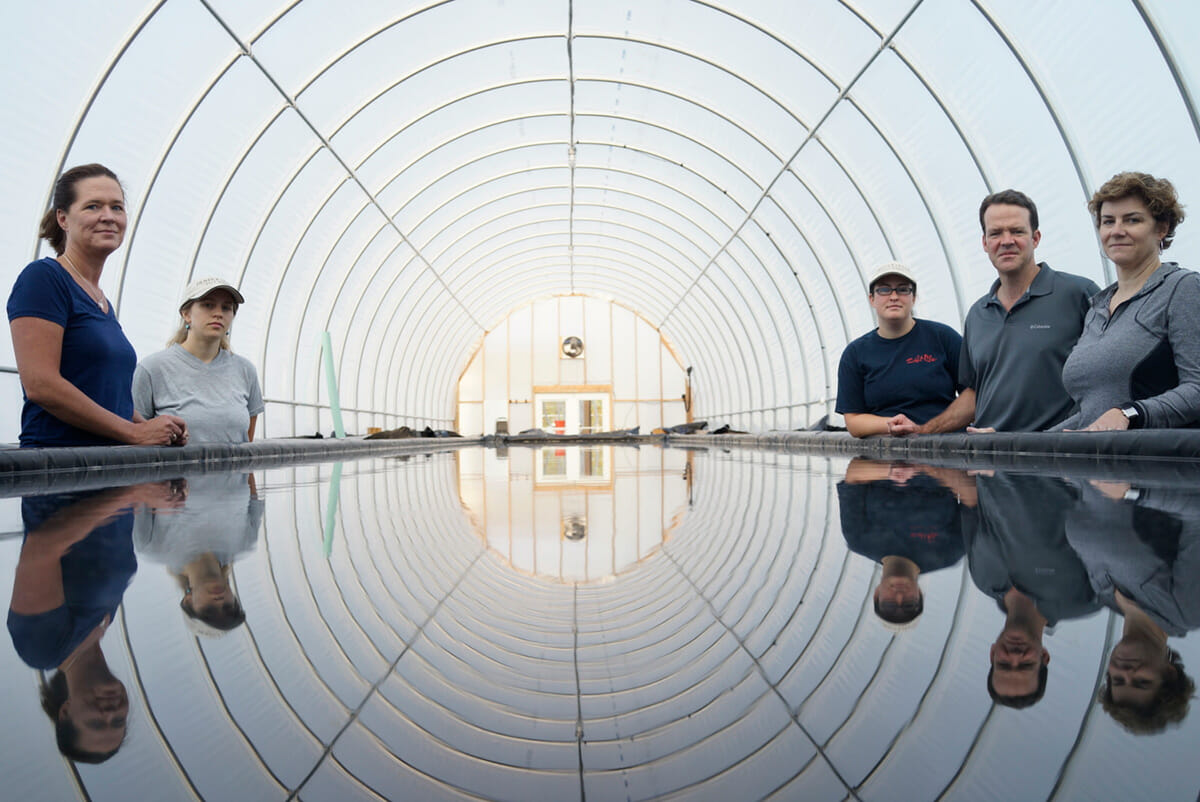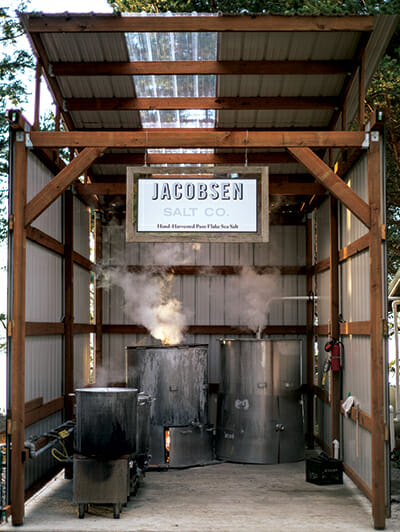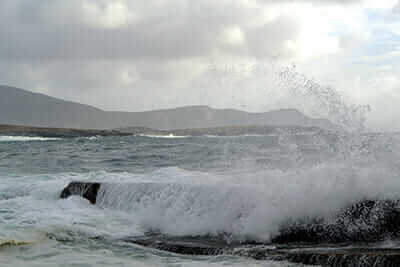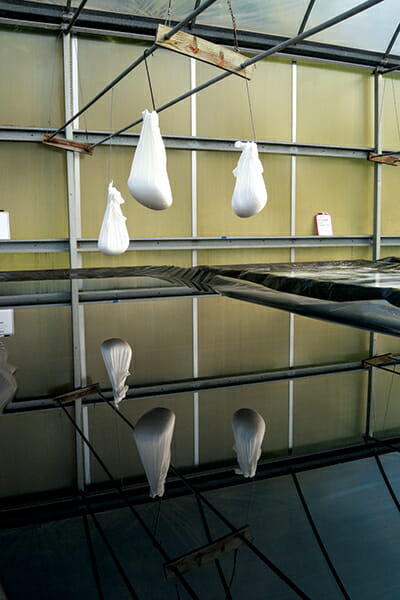Shaking Up Salt
Is salt terroir (or merroir, in the case of sea salt) really a thing, or is it just food-world nonsense?
Shaking Up Salt
Is salt terroir (or merroir, in the case of sea salt) really a thing, or is it just food-world nonsense?

Terroir has left the vineyard.
The French concept of terroir has long been a cause célÁ¨bre in the wine world. But today the term, which describes the singular taste imparted by a product’s environs, turns up when discussing everything from cider to maple syrup.
Now, it’s salt’s turn.
Salt lovers get ready: A new breed of entrepreneurially minded salt farmers – from Martha’s Vineyard to the Philippines to West Virginia (see sidebar) – is looking to their own backyards.
What Vogue food critic Jeffrey Steingarten called “salt chic” over a decade ago has gone mainstream. Global salt hotspots – France’s fleur de sel, Britain’s Maldon, Himalayan pink salt and a handful of others – are big sellers. This year, global gourmet salt sales are estimated to top $250 million, and the market is expected to grow by over six percent between 2014 and 2019.
But is salt terroir (or merroir, in the case of sea salt) really a thing, or is it just food-world nonsense?

The boil room at the Jacobsen Salt Co. facility in Netarts, Oregon.

Winter waves break on Achill Island.
Marjorie O’Malley and her family are salt farmers on secluded Achill Island, off Ireland’s western shore. They harvested their first batch in 2013, boiling seawater (which O’Malley, an accountant by trade, believes to be superior due to wild island winters that “churn and aerate the waters”) on their kitchen stove. Thus, Achill Island Sea Salt was born. Sales are growing weekly (roughly $3.80 buys a little over two-and-a-half ounces) and they’ve moved production into a small commercial kitchen. Ultan Cooke, chef at Western Ireland’s Michelin-starred restaurant Aniar, says, “It has a flavor in its own right, which goes well with fish and, especially, lamb.”
Traditionally, this flavor is what many salt producers avoided; in its pure form, salt – sodium chloride – is strictly a flavor enhancer. “The goal of salt-making was always to make all salt the same and make it all pure white,” says Mark Kurlansky, author of “Salt: A World History.” Until the 20th century, Kurlansky says, many different salts were produced, but when mechanical evaporation took hold, the dream of a reliably pure salt was realized. But the gourmet food movement changed all that. “I guess people got bored with it, so now they want to go back to having basically all these flawed salts,” says Kurlansky, no booster of snooty salt.
Two factors inform salt’s flavor: the shape of the crystal and impurities retained through minimal processing.
“There’s gunk in there,” says Benjamin Wolfe, assistant professor of microbiology at Tufts University. Two factors inform salt’s flavor: the shape of the crystal and impurities retained through minimal processing. The presence of microorganisms can also affect the flavor of some foods. Microbes weren’t thought to live on salt until recently, as its hostility to bacterial life is what makes it an excellent preserver. Wolfe says scientists are “changing our thinking on what salt is and the nature of salt” as they look at how minimally processed versions can serve as “vectors of taste” in fermented foods; in South Korea, scientists have studied the use of Korean sea salt in kimchi.
Impurities – “phytoplankton and bacteria and little bits of dirt,” Wolfe says – can also impart distinct qualities that are more readily apparent. For example, France’s beloved gray salt gets its distinctive color from the salt pans on which it dries.
Impurities and microbes are nothing to worry about “if you’re going to put it on scrambled eggs right away,” says the appropriately named Morton Satin, self-described “salt guru” and vice president of science and research at The Salt Institute. Added to a dish right before serving, microbes don’t have time to grow their numbers. Even in fermented foods, you’d have to consume mountains of salt to ingest a notable number of microbes. “The amount of salt you would be eating would be a bigger problem than a microbial cell or two,” Wolfe says. In fact, the kimchi study speculated that natural sea salt actually encouraged cancer-fighting microorganisms.

Freshly harvested salt drains in cotton cloths in JQD’s sun house.

New salt crystals form in the crystallization beds, ready for harvest.
Ben Jacobsen, who founded Jacobsen Salt Co. on the Oregon Coast in 2011, is a merroir believer. He tried seawater from 30 different locations before finding one that produced the flavor he liked: “very briny with no bitter aftertaste.” (Chef Matt Abdoo of New York’s culinary temple Del Posto says the salt “has a clean flavor with a fantastic textural component.”) But local isn’t enough, Jacobsen says, unless you back it up with quality. Of the dozen or so small salt farmers he’s aware of in the U.S., he says, “A lot of the salts are good, but a lot of the salts are very, very average.”
‘And local means different things to different people. One Manhattan salt “farm” offers salt produced from Long Island seawater dried on a New York rooftop; the terroir of Midtown holds dubious appeal.
Still, the promise of truly high-quality, local salt has plenty of salt lovers excited – if the subtle flavors aren’t obvious, the connection to a local producer is. It’s just not for the faint of heart. “If you’re a purist and you’re really trying to have consistency,” Wolfe says, “I think you’re going to go with the Mortons.” As for the rest of us, anyone worth her salt knows fortune favors the bold.
JQD Salt-Works in Malden, West Virginia
The Dickinson family has been on the Appalachian Mountain land that houses J.Q. Dickinson Salt-Works for about 182 years; the salt has been there for about 400 million. It comes from the dried remains of the Iapetus Ocean, an ancient sea deep beneath what is now Malden, West Virginia, where Nancy Bruns and Lewis Payne launched JQD in 2013.
The siblings are seventh-generation salt farmers with an asterisk: JQD is named after the salt farm that their great-times-four grandfather started in 1832 – when the state’s Kanawha Valley was a salt-making powerhouse – but that farm shuttered in 1945. Bruns knew about the old family business and wondered if the area had run out of brine. No, her husband said, there’s plenty. “I think I need to be making salt,” she told him.
Bruns, 48, a former chef, and Payne, 44, a former attorney, pump the subterranean brine – freshwater from a spring that dissolves the salt stores – up through a 350-foot well and into a sun house, where it evaporates in shallow beds. The brine then travels to another sun house where it crystallizes until it can be harvested, dried, cleaned and packaged; each batch takes about a month. Salt from underground aquifers is rare – although Bruns and Payne say that the practice is common in a remote area of Peru – but the result, Payne says, is a more consistent flavor than that of salt derived from ocean water.
They have over 80 clients for the finishing salt, including chef Sean Brock. They run a more boutique operation than their forebears, but they’re happy to be back in the family business. “That’s been the most rewarding part, to learn how the business worked, how difficult it was,” Payne says. “To be a part of that timeline is a great feeling.”
– Courtney Balestier
Top: Siblings Lewis Payne and Nancy Bruns, owners of JQD Salt-Works in West Virginia, stand with members of their team in the evaporation sun house.
Follow us

This work is licensed under a Creative Commons Attribution-NoDerivatives 4.0 International License.
Want to republish a Modern Farmer story?
We are happy for Modern Farmer stories to be shared, and encourage you to republish our articles for your audience. When doing so, we ask that you follow these guidelines:
Please credit us and our writers
For the author byline, please use “Author Name, Modern Farmer.” At the top of our stories, if on the web, please include this text and link: “This story was originally published by Modern Farmer.”
Please make sure to include a link back to either our home page or the article URL.
At the bottom of the story, please include the following text:
“Modern Farmer is a nonprofit initiative dedicated to raising awareness and catalyzing action at the intersection of food, agriculture, and society. Read more at <link>Modern Farmer</link>.”
Use our widget
We’d like to be able to track our stories, so we ask that if you republish our content, you do so using our widget (located on the left hand side of the article). The HTML code has a built-in tracker that tells us the data and domain where the story was published, as well as view counts.
Check the image requirements
It’s your responsibility to confirm you're licensed to republish images in our articles. Some images, such as those from commercial providers, don't allow their images to be republished without permission or payment. Copyright terms are generally listed in the image caption and attribution. You are welcome to omit our images or substitute with your own. Charts and interactive graphics follow the same rules.
Don’t change too much. Or, ask us first.
Articles must be republished in their entirety. It’s okay to change references to time (“today” to “yesterday”) or location (“Iowa City, IA” to “here”). But please keep everything else the same.
If you feel strongly that a more material edit needs to be made, get in touch with us at [email protected]. We’re happy to discuss it with the original author, but we must have prior approval for changes before publication.
Special cases
Extracts. You may run the first few lines or paragraphs of the article and then say: “Read the full article at Modern Farmer” with a link back to the original article.
Quotes. You may quote authors provided you include a link back to the article URL.
Translations. These require writer approval. To inquire about translation of a Modern Farmer article, contact us at [email protected]
Signed consent / copyright release forms. These are not required, provided you are following these guidelines.
Print. Articles can be republished in print under these same rules, with the exception that you do not need to include the links.
Tag us
When sharing the story on social media, please tag us using the following: - Twitter (@ModFarm) - Facebook (@ModernFarmerMedia) - Instagram (@modfarm)
Use our content respectfully
Modern Farmer is a nonprofit and as such we share our content for free and in good faith in order to reach new audiences. Respectfully,
No selling ads against our stories. It’s okay to put our stories on pages with ads.
Don’t republish our material wholesale, or automatically; you need to select stories to be republished individually.
You have no rights to sell, license, syndicate, or otherwise represent yourself as the authorized owner of our material to any third parties. This means that you cannot actively publish or submit our work for syndication to third party platforms or apps like Apple News or Google News. We understand that publishers cannot fully control when certain third parties automatically summarize or crawl content from publishers’ own sites.
Keep in touch
We want to hear from you if you love Modern Farmer content, have a collaboration idea, or anything else to share. As a nonprofit outlet, we work in service of our community and are always open to comments, feedback, and ideas. Contact us at [email protected].by Cara Parks, Modern Farmer
December 16, 2014
Modern Farmer Weekly
Solutions Hub
Innovations, ideas and inspiration. Actionable solutions for a resilient food system.
ExploreExplore other topics
Share With Us
We want to hear from Modern Farmer readers who have thoughtful commentary, actionable solutions, or helpful ideas to share.
SubmitNecessary cookies are absolutely essential for the website to function properly. This category only includes cookies that ensures basic functionalities and security features of the website. These cookies do not store any personal information.
Any cookies that may not be particularly necessary for the website to function and are used specifically to collect user personal data via analytics, ads, other embedded contents are termed as non-necessary cookies.